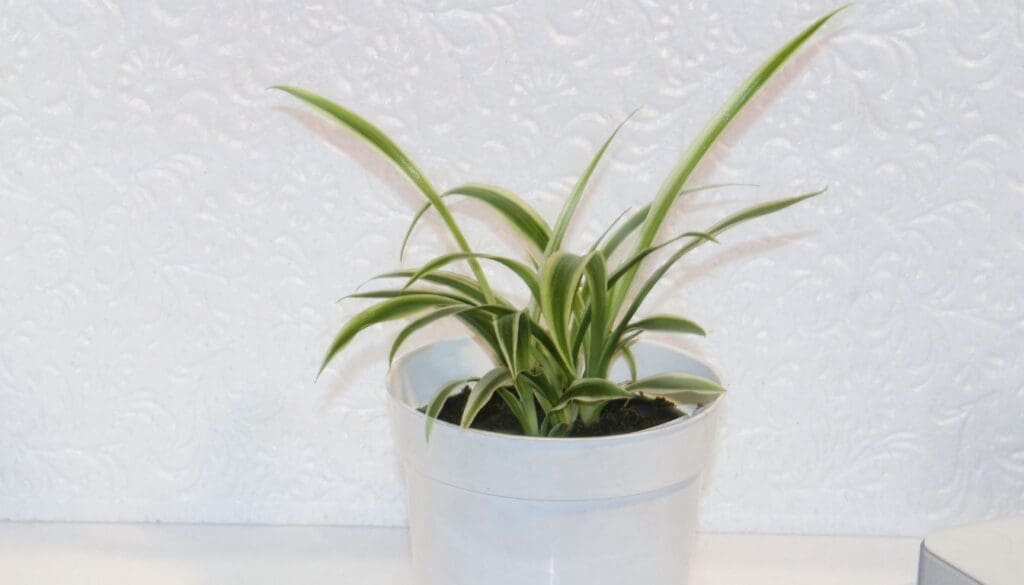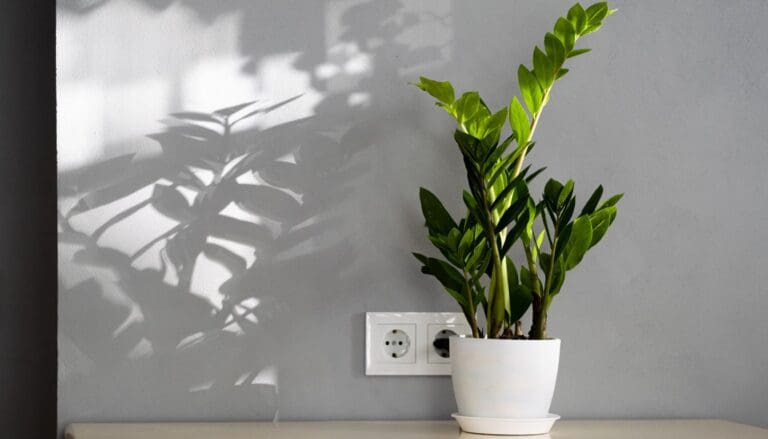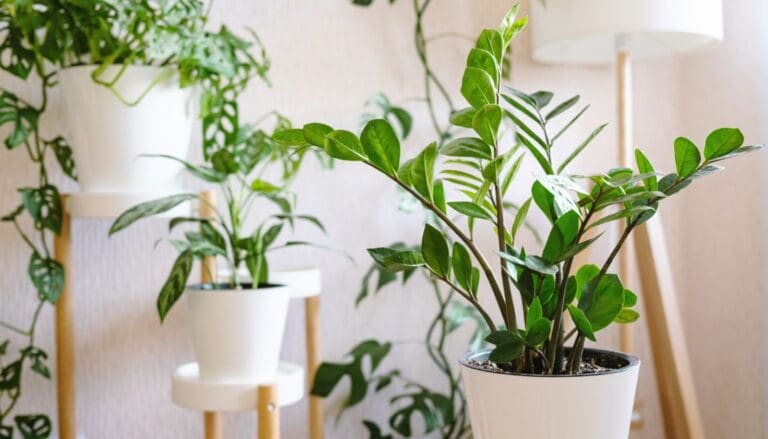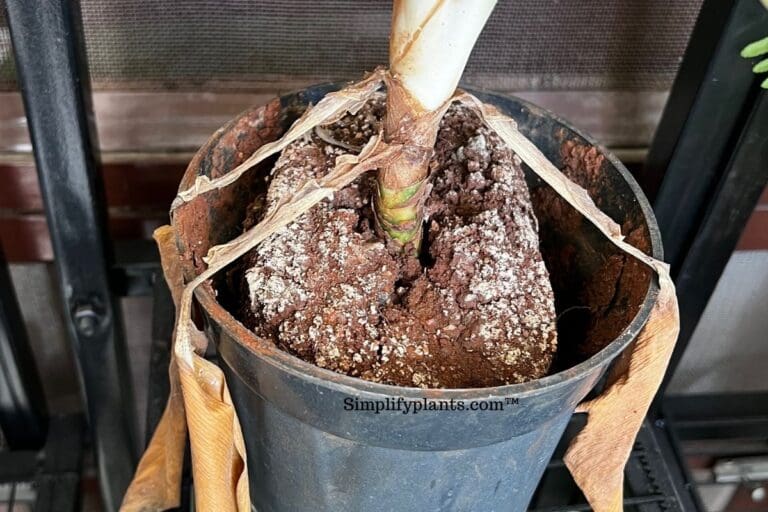12 Signs Of Overwatering Houseplants (+How To Fix It)
Water, along with light, soil, and air, constitute the necessities without which no plants can survive. But the watering requirement of the plants is something many plant growers often misunderstand, resulting in overwatering their plants.
Every plant has different water needs. Some need moisture, while some prefer a drier soil. Overwatering your plants can be very dangerous. It can lead to problems like root rot, mold growth, fungus diseases, wilting, and many more because most houseplants prefer light soil with plenty of airflows.
In this article, we will discuss different reasons that lead to overwatering, signs of an overwatered plant, and ways to fix this problem and get your plant back. So please keep reading.

Please note: Simplify Plants is reader-supported. Some links in the post are affiliate links and I get a commission from purchases made through links in the post.
Importance of water for plants
Plants absorb water from the environment and convert it into glucose, which helps the plants grow.
The roots of the plants require both water and oxygen to grow, but when the plant is overwatered, it makes the soil soggy where there is no airflow, and the roots fail to breathe.
The overwatered plant sends warning signals to show the problem, and if we identify and treat it immediately by cutting down water, we can save the plant.
But if we ignore this and keep watering the plant, it would lead to several problems, making it difficult for the plant to recover.
Staying in wet soil for a long time causes root rot, the most advanced stage of overwatering, and it is also quite tricky to save the rotten plant.
The plant shows several signs of its struggle.
What is overwatering?
Overwatering is the major reason that kills most houseplants worldwide.
Even the most experienced plant owners have lost at least one plant to overwatering.
Overwatering is when the plant gets more water than it requires, making it unable to absorb all that water.
As a result, the soil gets saturated with water.
The soggy soil restricts oxygen flow, suffocating the roots, and leading to the growth of pathogens and bacteria, causing root rot.
If the overwatering is at an initial stage, it is easy to cure, but once you keep overwatering a plant for a prolonged period, it might get serious for the plant to recover
Signs of overwatered plants
In this section, we will discuss each of the symptoms your plants show if they have been overwatered for a long time.
By identifying these signs early, you can save your plants from dying.
1. Yellowing leaves

When a plant stands in soggy soil for a long time, it develops yellow leaves.
The green foliage begins to lose its color and turn yellow and limp.
Yellow leaves can also be a sign of underwatering or too much sun exposure, so you have to check the soil to confirm the soil’s condition.
But if the leaves are yellow and limp, and the soil is wet constantly, it is mostly a sign of overwatering.
2. Wet soggy soil
The soil of an overwatered plant remains wet and compact all the time.
This condition of plants is very harmful because most houseplants enjoy loose light soil and good drainage.
Unless you have recently watered the plant, the soil should feel loose and airy, and if it is still moist at all times, it might be a sign of overwatering.
3. Mushy stems

A plant dealing with the stress of overwatering begins to lose its firm and strong stem, and instead, it turns mushy and soft because it has too much moisture in them.
4. Brown edges or spots on the plant
A plant that has been overwatered for a long time begins to show its stress through the brown and blackened leaves’ tips and edges.
If left untreated, the browning quickly progresses to cover the entire leaves.
5. Pest infestation

An overwatered plant becomes the breeding ground for pests.
Plants living in wet soil are frequently attacked by mealybugs, aphids, gnats, scales, and many other bugs because they thrive in damp conditions.
6. Leaves dropping
Leaves that have naturally aged drop off on their own.
But if you notice young and, new leaves are losing their color and dropping off, that can indicate that your plant is overwatered.
7. Mold on the soil surface
Mold is a type of bacteria that loves damp conditions.
Soil that always stays wet and does not get oxygen circulation to dry soil develops mold and fungus in them.
You may have noticed the soil surface has a white mold-like layer.
When left unchecked, this mold will spread to the stem and leaves of the plant.
8. Foul odor from the soil

When the overwatering starts to damage the plant’s roots, the soil emits a foul odor.
This is one of the signs of root rot, and we should not neglect it and immediately take action.
9. Root rot
Root rot is the most dangerous and advanced overwatering stage and is the most common reason for killing potted plants.
Root rot happens when the suffocated roots in the soggy soil stay cut off from oxygen circulation and begin to rot by pathogens and fungus gradually.
As root rot progresses, the roots become black, mushy, and smelly as the rot-causing pathogens attack the root.
Plants mostly live for 8-10 days after the root rot has begun; for some plants, this period is even lower.
10. Slower growth

You must have noticed that every plant has a natural growth rate.
Some plants grow very slowly, whereas some grow faster.
When you notice your plant has suddenly stopped growing, is drooping has many yellow or brown leaves, you might suspect a root rot has set in.
11. Wilting
An overwatered plant looks droopy and limp, although it has enough water in the soil.
This is because the roots are saturated with water and can no longer breathe and absorb oxygen, which is why it begins to wilt.
12. Edema
You might not have heard of this term before, but this kind of disease affects the roots of your plants when it gets too much water.
Sometimes when you have overwatered your plant for a long time, have you noticed tiny blister-like formations on the leaves?
This is edema that has affected your plants.
When the roots get too much water, the pressure of the water on the plant cells increases.
The plant cannot use the water in a meaningful way, so it ends up bursting the internal cells of the plant, forming blisters.
Soon enough, these blisters will erupt and form warts in brown, tan, or white colors.
If you do not treat the edema, the plant’s condition worsens.
The blistering will spread to the stem and petiole, turn yellow, and start falling off.
How to fix an overwatered plant?

Once you have identified the signs of overwatering in your plant, it is time to fix the problem.
- If the overwatering is at its initial stage, tackling the problem is easy. Simply cut back on watering your plant. Wait for the soil to get completely dry before watering it again. Stick your finger inside the soil or use a moisture meter to check the moisture content of the soil and decide whether it needs water.
- If the plant is in a low-lit area, change its location to a well-lit area. Light and air flow help to dry the soil quickly. This is why plants in low-light areas need more time to dry the soil.
- Poke the soil with a chopstick to make several holes to allow air circulation inside the soil and dry it faster.
- Trim the yellow or brown leaves of the plant as they are not going to get green again, and keeping those leaves will only waste more energy.
If the overwatering is more advanced and the plant’s condition is more serious, you need to put in more effort.
If you suspect that root rot pathogens have attacked your plant, you must take more steps.
- Prune all the mushy and dead parts of the plant.
- Carefully pull the plant out of the pot.
- Wash the roots under running water to remove the soil attached to the roots.
- Inspect the roots thoroughly and check for signs of rotting.
- Trim off all the rotten black or soggy roots with a sterilized pruner.
- Prepare a fresh soil mix for the plant. You can use the available soil mix in the market or prepare one by mixing soil, sand, cocopeat, crushed charcoal, and compost.
- Fill up a new pot no more than 2 inches bigger than the existing pot with soil, and gently place the plant in the middle.
- Keep the newly potted plant in a place that receives bright indirect light. Water it thoroughly until it runs off the drain hole, and then do not water it again until the soil is dry.
- Do not add any additional fertilizer to the already stressed plant, and see how it adjusts to the repotting.
Luckily it is easy to understand how much water your plant needs.
With experience and practice, you will gradually understand your plant’s needs, frequencies, and quantity of water.
- First and foremost, you must find out what the kind of plant is. Succulents and desert plants need a lot less water than tropical plants. So, a plant like a snake plant, cactus, or any plant that belongs to dessert regions will need much less water, maybe once in 7-15 days, depending on the temperature. But plants like Calathea or Boston Ferns that belong to the tropical regions need more moisture and water to flourish.
- Another important thing that matters is the material of the pot. Plants in clay pots need more water than non-porous materials like plastic and ceramic. This is because the soil in clay pots dries faster. After all, it allows airflow into the soil, so you need to water your plants growing in non-porous pots less frequently. Plants growing in plastic pots have a higher chance of getting overwatered than those growing in clay pots.
- If you are unsure about your plants’ watering needs, using a moisture meter or finger test is a great and effective way to prevent overwatering. A moisture meter is a device that you have to dip in the soil and shows the soil’s water content.
- Using pots with a drainage hole is very important to prevent overwatering. Drainage holes allow excess water to escape the pot instead of staying in the pot. Without drainage holes, the water stays inside, keeping the soil soggy constantly, ultimately leading to root rot and diseases. Nowadays, many decorative pots are available for indoor plants with no drainage holes at the bottom. Though they look very pretty, they are not good for your plants. If you want to get these fancy pots for your home, there is a solution. You have to grow your plant in a simple clay pot with a hole and then put that pot inside these clay pots. Before watering, take the pit out of the fancy pot, water it, let the excess water drain out of the hole, and then put it inside the bigger pot.
- Always remember to empty the cache and trays under the pots. If the pot sits in the water for a long time, it will keep the roots wet and lead to root rot problems.
- Keep your plants in well-ventilated and brightly lit areas because it allows the soil to dry up faster through evaporation. Plants in low-light damp areas are more likely to suffer from overwatering.
- Whenever you water, water thoroughly until it runs off the drain hole instead of shallow watering.
- Change the watering schedule of your plants as per season and temperature. In spring and summer, it requires more water than it does in winter. The plant needs less water in winter due to low light and less evaporation.
Final words
Overwatering is a mistake most plant lovers have committed at some point or the other. Though it is a serious concern if left untreated for a long time, in the initial stages, you can treat the plant if taken necessary actions.
If you find it difficult to understand when you must water the plant, understand the plant type thoroughly and do the research.
In this article, I have discussed the signs and prevention of this problem elaborately, and I hope you will get a better idea about treating the issue after reading this article. Remember, the sooner you identify and treat the problem, the more chances you have to save your plant.
Recommended Garden Supplies
| Product Image | Our Recommended Gardening Supplies | Check Offers! |
|---|---|---|
Top Top
Top
Top
Top
Top
Top
Top
Top | rePotme Houseplant and Tropical Classic Potting Soil Mix | Check Offer On Amazon |
 Top
Top
Top
Top
Top
Top
Top
Top | Espoma Organic Indoor Plant Food | Check Offer On Amazon |
 Top
Top
Top
Top
Top
Top
Top
Top | GooingTop LED Grow Light 6000K Full Spectrum Clip Plant Growing Lamp | Check Offer On Amazon |
 Top
Top
Top
Top
Top
Top
Top
Top | Soil Moisture Meter | Check Offer On Amazon |
 Top
Top
Top
Top
Top
Top
Top
Top | Govee Hygrometer Thermometer, Bluetooth Enabled! | Check Offer On Amazon |
 Top
Top | LEVOIT Humidifiers for Large Room(Best For Plants) | Check Offer On Amazon |
 Top
Top
Top
Top
Top
Top
Top
Top | Upgraded DIY Automatic Drip Irrigation Kit, 15 Potted Houseplants Support | Check Offer On Amazon |
 Top
Top
Top
Top
Top
Top
Top
Top | Stainless Steel Heavy Duty Gardening Tool Set | Check Offer On Amazon |
 Top
Top
Top
Top
Top
Top
Top
Top | Bonide Insecticidal Soap | Check Offer On Amazon |
 Top
Top
Top
Top
Top
Top
Top
Top | Bonide 32 oz Spray Neem Oil for Organic Gardening | Check Offer On Amazon |
 Top
Top
Top
Top
Top
Top
Top
Top | Garden Safe Fungicide | Check Offer On Amazon |







I have a peace lily that is dooping n light green leaves n not very big as the ones I have seen I transplanted it in good soil with fertilizer in it n it still looks the same it’s been a week I watered it till water came out on bottom still damp so what have I done wrong n can I fix it or just buy a new one.
Hi diane,
It’s common for peace lilies to experience some stress after repotting. Give it some time to adjust—usually a few weeks. Ensure it’s not overwatered and is in a spot with bright, indirect light. Avoid direct sunlight, which can scorch the leaves. If the soil is still damp, hold off on watering until the top inch feels dry. There’s no need to buy a new one yet; with proper care, it should recover.
Hope your peace lily does well!